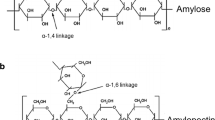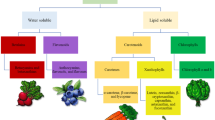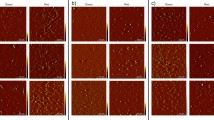Abstract
Unripe banana flour is a premium nutritious product with a potential to curb degenerative diseases through resistant starch and gluten free traits, however, with scant techniques to monitor adulteration practices. The objective of the present study was to determine the efficacy of visible–near infrared spectroscopy (Vis–NIR) spectroscopy (Vis–NIRS) in the detection and quantification of unripe banana flour adulteration with wheat flour. To do this, simulated adulteration of a composite banana flour was performed with different levels of wheat flour, in intervals of 20 g kg−1, ranging from 0 to 800 g kg−1. Each level was acquired in duplicate giving a total of 82 samples. Vis–NIR spectral data was acquired using a portable F-750 spectrometer in the range 447–1005 nm. Spectral data was analysed chemometrically using principle components analysis and partial least squares regression (PLSR), with 41 samples used as a calibration set and 41 for validation. The first two principal components accounted for 95% of spectral data variation, revealing five distinct clusters related to 0 g kg−1, 20–200 g kg−1, 220–400 g kg−1, 420–600 g kg−1 and 620–800 g kg−1 adulterated samples. The best PLSR model to predict wheat flour adulteration degrees in unripe banana flour was obtained using 2nd derivative Savitzky–Golay (19-point smoothing, 2nd order polynomial), showing the highest R2c (0.991); R2p (0.993); RPD (12.021) and the lowest RMSEC (2.226 g kg−1) and RMSEP (1.993 g kg−1) values. The obtained Vis–NIRS PLSR models therefore demonstrated the technology novelty in monitoring unripe banana flour quality by the processing industries and in retail markets during product verification.




Similar content being viewed by others
References
Agama-Acevedo E, Sañudo-Barajas J, Vélez De La Rocha R, González-Aguilar G, Bello-Perez LA (2016) Potential of plantain peels flour (Musa paradisiaca L.) as a source of dietary fiber and antioxidant compound. J Food 14:117–123. https://doi.org/10.1080/19476337.2015.1055306
Almeida-Junior LD, Curimbaba TFS, Chagas AS, Qualia AEV, Di Stasi LC (2017) Dietary intervention with green dwarf banana flour (Musa sp. AAA) modulates oxidative stress and colonic SCFAs production in the TNBS model of intestinal inflammation. J Funct Food 38:497–504. https://doi.org/10.1016/j.jff.2017.09.038
Ambrose A, Cho BK (2014) A review of technologies for detection and measurement of adulterants in cereals and cereal products. J Bios Eng 39(4):357–365. https://doi.org/10.5307/JBE.2014.39.4.357
Anyasi TA, Jideani AI, Mchau GR (2013) Functional properties and postharvest utilization of commercial and noncommercial banana cultivars. Compr Rev Food Sci Food Saf 12(5):509–522. https://doi.org/10.1111/1541-4337.12025
Apostolopoulos V, Antonipillai J, Tangalakis K, Ashton JF, Stojanovska L (2017) Let’s go bananas! Green bananas and their health benefits. Pril 38:147–151. https://doi.org/10.1515/prilozi-2017-0033
Bellon-Maurel V, Fernandez-Ahumada E, Palagos B, Roger JM, Mcbratney A (2010) Critical review of chemometric indicators commonly used for assessing the quality of the prediction of soil attributes by NIR spectroscopy. TrAC Anal Chem 29:1073–1081. https://doi.org/10.1016/j.trac.2010.05.006
Che W, Sun L, Zhang Q, Zhang D, Ye D, Tan W, Wang L, Dai C (2017) Application of visible/near-infrared spectroscopy in the prediction of Azodicarbonamide in wheat flour. J Food Sci 82:2516–2525. https://doi.org/10.1111/1750-3841.13859
Dan MC, Cardenette GH, Sardá FA, Giuntini EB, Bello-Pérez LA, Carpinelli ÂR, Lajolo FM, Menezes EW (2015) Colonic fermentation of unavailable carbohydrates from unripe banana and its influence over glycemic control. Plant Food Hum Nutr 70:297–303. https://doi.org/10.1007/s11130-015-0493-6
Davey MW, Saeys W, Hof E, Ramon H, Swennen R, Keulemans J (2009) Application of visible and near-infrared reflectance spectroscopy (Vis/NIRS) to determine carotenoid contents in banana (Musa spp.) fruit pulp. J Agric Food Chem 57:1742–1751. https://doi.org/10.1021/jf803137d
Everstine K, Spink J, Kennedy S (2013) Economically motivated adulteration (EMA) of food: common characteristics of EMA incidents. J Food Prot 76:723–735. https://doi.org/10.4315/0362-028X.JFP-12-399
Farage, De Medeiros-Nóbrega YK, Pratesi R, Gandolfi L, Assunção P, Zandonadi RP (2017) Gluten contamination in gluten-free bakery products: a risk for coeliac disease patients. Public Health Nutr 20:413–416. https://doi.org/10.1017/S1368980016002433
Jha SN, Jaiswal P, Borah A, Gautam AK, Srivastava N (2015) Detection and quantification of urea in milk using attenuated total reflectance-fourier transform infrared spectroscopy. Food Bioprocess Technol 8(4):926–933. https://doi.org/10.1007/s11947-014-1455-y
Kongolo JI, Da Silva LS, Wokadala OC, Du Plessis B, Husselman J, Ngcobo MEK, Emmambux NM, Daneel M (2017) Pasting, thermal, gel texture, resistant starch and colour properties of unripe banana flour from 10 desert banana varieties cultivated in South Africa. J Food Meas 11:1056–1064. https://doi.org/10.1007/s11694-017-9481-x
Lohumi S, Lee S, Lee H, Cho BK (2015) A review of vibrational spectroscopic techniques for the detection of food authenticity and adulteration. Trends Food Sci Technol 42:85–98. https://doi.org/10.1016/j.tifs.2015.08.003
Magwaza LS, Naidoo SIM, Laurie SM, Laing MD, Shimelis H (2016) Development of NIRS models for rapid quantification of protein content in sweetpotato [Ipomoea batatas (L.) LAM.]. Food Sci Technol 72:63–70. https://doi.org/10.1016/j.lwt.2016.04.032
Mahesh S, Jayas DS, Paliwal J, White NDG (2015) Hyperspectral imaging to classify and monitor quality of agricultural materials. J Stored Prod Res 61:17–26. https://doi.org/10.1016/j.jspr.2015.01.006
McGoverin CM, September DJF, Geladia P, Manleya M (2012) Near-infrared and mid-infrared spectroscopy for the quantification of adulterants in ground black pepper. J Near Infrared Spec 20:521–528
Mishra P, Herrero-Langreo A, Barreiro P, Roger JM, Diezma B (2015) Detection and quantification of peanut traces in wheat flour by near infrared hyperspectral imaging spectroscopy using principal-component analysis. J Near Infrared Spec 23(1):15–22
Moscetti R, Saeys W, Keresztes JC, Goodarzi M, Cecchini M, Danilo M, Massantini R (2015) Hazelnut quality sorting using high dynamic range short-wave infrared hyperspectral imaging. Food Bioprocess Technol 8:1593–1604. https://doi.org/10.1007/s11947-015-1503-2
Naes T, Nyvold TE (2004) Creative design-an efficient tool for product development. Food Qual Prefer 15:97–104. https://doi.org/10.1016/S0950-3293(03)00036-3
Nawrocka A, Lamorska J (2013) Determination of food quality by using spectroscopic methods. Adv Agrophys Res 14:347–367. https://doi.org/10.5772/52722
Ncama K, Magwaza LS, Poblete-Echeverría CA, Nieuwoudt HH, Tesfay SZ, Mditshwa A (2018) On-tree indexing of ‘Hass’ avocado fruit by non-destructive assessment of pulp dry matter and oil content. Biosyst Eng 174:41–49. https://doi.org/10.1016/j.biosystemseng.2018.06.011
Nicolaï BM, Beullens K, Bobely E, Peirs A (2007) Nondestructive measurement of fruit and vegetable quality by means of NIR spectroscopy: a review. Postharvest Biol Technol 46:99–118. https://doi.org/10.1016/j.postharvbio.2007.06.024
Osborne GB (2006) Near-infrared spectroscopy in food analysis. In: Encyclopedia of analytical chemistry: applications, theory and instrumentation, pp 1–14. https://doi.org/10.1002/9780470027318.a1018
Patiño-Rodrígueza O, Bello-Pérezb LA, Flores-Silvac PC, Sánchez-Riverab MM, Romero-Bastida CA (2018) Physicochemical properties and metabolomic profile of gluten-free spaghetti prepared with unripe plantain flours. Food Sci Technol 90:297–302. https://doi.org/10.1016/j.lwt.2017.12.025
Qu JH, Liu D, Cheng JH, Sun DW, Ma J, Pu H, Zeng XA (2015) Applications of near-infrared spectroscopy in food safety evaluation and control: a review of recent research advances. Crit Rev Food Sci Nutr 55:1939–1954. https://doi.org/10.1080/10408398.2013.871693
Rinnan Å, van den Berg F, Engelsen SB (2009) Review of the most common pre-processing techniques for near-infrared spectra. TrAC Anal Chem 28(10):1201–1222. https://doi.org/10.1080/10408398.2013.871693
Sardá FAH, de Lima FN, Lopes NT, Santos ADO, Tobaruela EDC, Kato ET, Menezes EW (2016) Identification of carbohydrate parameters in commercial unripe banana flour. Food Res Inter 81:203–209. https://doi.org/10.1016/j.foodres.2015.11.016
Savitzky A, Golay MJ (1964) Smoothing and differentiation of data by simplified least squares procedures. Anal Chem 36(8):1627–1639. https://doi.org/10.1021/ac60214a047
Scarminio V, Fruet AC, Witaicenis A, Rall VLM, Di Stasi LC (2012) Dietary intervention with green dwarf banana flour (Musa sp AAA) prevents intestinal inflammation in a trinitrobenzenesulfonic acid model of rat colitis. Nutr Res 32:202–209. https://doi.org/10.1016/j.nutres.2012.01.002
Schneider A (2011) Asian honey banned in Europe is flooding US grocery shelves. In: Food safety news. IOP Publishing PhysicsWeb. https://www.foodsafetynews.com/2011/08/honey-laundering/. Accessed 09 Aug 2018
Singh R, Kaushik R, Gosewade RKS (2018) Bananas as underutilized fruit having huge potential as raw materials for food and non-food processing industries: a brief review. Pharm Innov J 7(6):574–580
Stuart B (2004) Organic molecules. In: Infrared spectroscopy-fundermentals and applications. Analytical techniques in the sciences. Willy, Chichester, pp 71–93
Su WH, Sun DW (2017) Evaluation of spectral imaging for inspection of adulterants in terms of common wheat flour, cassava flour and corn flour in organic Avatar wheat (Triticum spp.) flour. J Food Eng 200:59–69. https://doi.org/10.1016/j.jfoodeng.2016.12.014
Torres MD, Arufe S, Chenlo F, Moreira R (2017) Coeliacs cannot live by gluten-free bread alone-every once in a while they need antioxidants. Int J Food Sci Technol 52:81–90. https://doi.org/10.1111/ijfs.13287
Acknowledgments
This research was supported by the Agricultural Research Council-Tropical and Subtropical Crops (ARC-TSC) through the Parliamentary Grand Project P03000019. The authors are grateful to Mr Lucio Zuma, Mr John Mthethwa and colleagues for agronomic support and assistance during fruit selection and harvesting.
Author information
Authors and Affiliations
Corresponding author
Additional information
Publisher's Note
Springer Nature remains neutral with regard to jurisdictional claims in published maps and institutional affiliations.
Rights and permissions
About this article
Cite this article
Ndlovu, P.F., Magwaza, L.S., Tesfay, S.Z. et al. Rapid visible–near infrared (Vis–NIR) spectroscopic detection and quantification of unripe banana flour adulteration with wheat flour. J Food Sci Technol 56, 5484–5491 (2019). https://doi.org/10.1007/s13197-019-04020-0
Revised:
Accepted:
Published:
Issue Date:
DOI: https://doi.org/10.1007/s13197-019-04020-0




